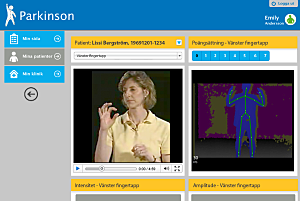Using Kinect to monitor Parkinson’s patients
Swedish neurologists and software developers have teamed up to create a potentially groundbreaking way to monitor patients with Parkinson’s disease. The secret ingredient? Kinect for Windows.
Softronic, an IT management and consulting company headquartered in Stockholm, joined forces with the renowned Karolinska University Hospital to create an easy-to-use, affordable way to follow up remotely with Parkinson’s patients. Taking advantage of Kinect’s depth sensing, high-definition video, and skeletal tracking, the application can assess five movements based on the Unified Parkinson’s Disease Rating Scale (URSDRS), a widely used tool for assessing the status of Parkinson patients. For example, the Kinect application measures finger taps (tapping the thumb with the index finger in rapid succession), leg agility (tapping the heel on the ground in rapid succession raising the leg), and rapid alternating movements of the hands (simultaneously moving the hands vertically and horizontally). The software analyzes the movement data and presents the results in an interface for the physician’s assessment.

The project's interface helps the physician easily assess the patient's status.
Parkinson’s patients routinely visit their physician just once or twice a year, but the Kinect-based application lets doctors remotely monitor patients on an as-needed basis. It thus enables the physician to focus on those patients whose condition merits additional remote follow-up and perhaps a change in medication—or even a trip to the clinic or hospital.

The system measures the patient's finger-tap ability, one of the standard
measurements used to assess the motor function of Parkinson's patients.
Another advantage of the system is its affordability, the Kinect sensor being far less costly than standard telemedicine equipment. Moreover, the presence of a Kinect sensor in the household does not indicate that someone is suffering from a disease, a comfort to patients who prefer to keep their condition private.
The system is currently undergoing clinical trials in Sweden, and the doctors and developers are already exploring additional functionality, particular gamification, which could make rehabilitation exercises more fun. They are also looking into using the system to help educate physicians about Parkinson’s disease and to provide data for second opinions.
The Kinect for Windows Team
Key links
- Kinect for Windows news and resources
- Download the free Kinect for Windows SDK 2.0
- Purchase the Kinect sensor
- Learn more about Parkinson's research at the Karolinksa Institute
- Follow us on Facebook and Twitter
Comments
Anonymous
April 01, 2015
Where this applicatiin can be downloaded?- Anonymous
January 27, 2016
We do not have a link to download this application, but you can learn more about the developers of this technology at the following URLs: Karolinska Institutet: https://kiedit.ki.se/en/about/startpage Softronic: http://www.softronic.se/en/
- Anonymous